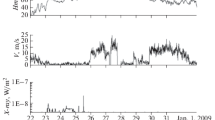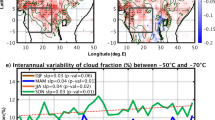Abstract
Winter thunderstorms in Kamchatka are a rare meteorological phenomenon. Temporal variations of the quasi-static electric field and meteorological values at the Paratunka observatory of the Institute of Cosmophysical Research and Radio Wave Propagation, Far East Branch, Russian Academy of Sciences (φ = 52.97° N; λ = 158.25° E), as well as data on solar, seismic and cyclonic activities available on INTERNET, are used to study the nature of this phenomenon. It is shown that powerful solar flares accompanied by increased radiation in the visible and infrared spectra, as well as the infrared radiation from the Earth that enters the atmosphere before powerful earthquakes with a magnitude of M > 8 may serve as an additional heat source in the surface atmosphere of Kamchatkan for the formation of thunderstorm activity. The contribution of tropical cyclones to these processes with weak seismic activity is not clearly defined and requires further detailed study.




Similar content being viewed by others
REFERENCES
Gornyi, V.I., Sal’man, A.G., Tronin, A.A., and Shilin, B.V., Outgoing IR radiation of the Earth—an indicator of seismic activity, Dokl. Akad. Nauk, 1988, vol. 301, no. 1, pp. 67–69.
Matveev, L.T., Fizika atmosfery (Atmospheric Physics), St. Petersburg: Gidrometeoizdat, 2000.
Mikhailova, G.A., Mikhailov, Yu.M., Kapustina, O.V., and Smirnov, S.E., Effects of thunderstorm activity in power spectra of the electric field in the near-surface atmosphere at Kamchatka, Geomagn. Aeron. (Engl. Transl.), 2010, vol. 50, no. 6, pp. 814–823.
Smirnov, S., Association of the negative anomalies of the quasistatic electric field in atmosphere with Kamchatka seismicity, Nat. Hazards Earth Syst. Sci., 2008, vol. 8, pp. 745–749.
Smirnov, S.E., Mikhailova, G.A., and Kapustina, O.V., Variations in the quasi-static electric field in the near-Earth’s atmosphere during geomagnetic storms in November 2004, Geomagn. Aeron. (Engl. Transl.), 2013, vol. 53, no. 4, pp. 502–514. https://doi.org/10.7868/S0016794013040147
Smirnov, S.E., Mikhailova, G.A., and Kapustina, O.V., Variations in electric and meteorological parameters in the near-Earth’s atmosphere at Kamchatka during the solar events in October 2003, Geomagn. Aeron. (Engl. Transl.), 2014, vol. 54, no. 2, pp. 240–247.
Smirnov, S.E., Mikhailova, G.A., Mikhailov, Yu.M., and Kapustina, O.V., Effects of strong earthquakes in variations of electrical and meteorological parameters of the near-surface atmosphere in Kamchatka region, Geomagn. Aeron. (Engl. Transl.), 2017, vol. 57, no. 5, pp. 610–617.
Veselovsky, I.S., Panasyuk, M.I., Avdyushin, S.I., et al., Solar and heliospheric phenomena in October–November 2003: Causes and effects, Cosmic Res., 2004, vol. 42, no. 5, pp. 435–488.
Yermolaev, Yu.I., Zelenyi, L.M., Zastenker, A.A., et al., A year later: Solar, heliospheric, and magnetospheric disturbances in November 2004, Geomagn. Aeron. (Engl. Transl.), 2005, vol. 45, no. 6, pp. 681–719.
Author information
Authors and Affiliations
Corresponding authors
Rights and permissions
About this article
Cite this article
Smirnov, S.E., Mikhailov, Y.M., Mikhailova, G.A. et al. Features of Winter Thunderstorms in Kamchatka. Geomagn. Aeron. 59, 696–703 (2019). https://doi.org/10.1134/S0016793219060112
Received:
Revised:
Accepted:
Published:
Issue Date:
DOI: https://doi.org/10.1134/S0016793219060112




